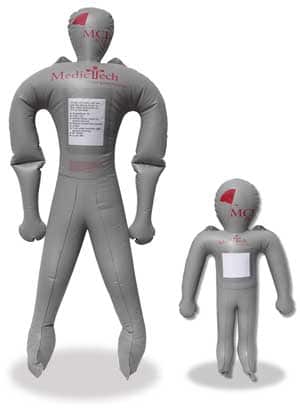In an emergency medical services (EMS), every second counts. When responding to a mass casualty incident (MCI), EMS personnel need to be able to quickly and efficiently assess the situation, triage patients, and provide life-saving care. MCI training is essential for ensuring that EMS personnel are prepared to handle these critical situations.
One of the most important tools used in MCI training is the MCI Ped or MCI mannequin. MCI mannequins are realistic-looking mannequins that simulate the size and weight of adult patients. This allows EMS personnel to practice patient assessment, triage, and treatment techniques in a safe and controlled environment.
What is the MCI Ped?
The MCI Ped is a specifically designed pediatric mannequin that is used to train EMS personnel in the care of children during MCIs. Children have unique medical needs that require specialized care, and the MCI Ped helps EMS personnel to develop the skills and knowledge necessary to provide effective care to pediatric patients in emergency situations.
The Benefits of Using the MCI Ped
There are many benefits to using the MCI Ped in MCI training, including:
- Improved patient assessment skills: The MCI Ped allows EMS personnel to practice assessing pediatric patients for signs and symptoms of injury or illness. This includes practicing taking vital signs, such as heart rate, respiratory rate, and blood pressure, as well as assessing for signs of head injury, shock, and other potential medical emergencies.
- Enhanced triage skills: Triage is prioritizing patients based on the severity of their injuries or illness. The MCI Ped helps EMS personnel to practice triaging pediatric patients in a realistic MCI scenario. This is essential for ensuring that the most critically ill patients receive care first.
- Developed treatment skills: The MCI Ped can be used to practice a variety of treatment techniques on pediatric patients, such as CPR, wound care, and medication administration. This allows EMS personnel to develop the skills and confidence they need to provide effective care to children in emergency situations.
- Increased confidence: Training with realistic mannequins, such as the MCI Ped, can help EMS personnel feel more confident and prepared to respond to MCIs involving children. This can lead to improved patient care and outcomes.
Features of the MCI Ped
The MCI Ped is a versatile training tool that offers a number of features to help EMS personnel develop the skills they need to care for pediatric patients in MCIs. Some of the key features of the MCI Ped include:
- Realistic size and weight: The MCI Ped is designed to simulate the size and weight of a real child. This allows EMS personnel to practice patient handling techniques in a realistic setting.
- Anatomical landmarks: The MCI Ped has anatomical landmarks that are important for patient assessment, such as palpable pulse points and fontanels.
- Durable construction: The MCI Ped is made from durable materials that can withstand repeated use in training exercises.
- Portable and easy to use: The MCI Ped is lightweight and portable, making it easy to transport and use in a variety of training settings.
How to Use the MCI Ped in MCI Training

The MCI Ped can be used in a variety of MCI training scenarios. Here are a few examples:
- Triage practice: EMS personnel can practice triaging pediatric patients using the MCI Ped. This can involve assessing the patients for signs and symptoms of injury or illness, and then assigning them a triage category based on the severity of their condition.
- Treatment practice: EMS personnel can practice a variety of treatment techniques on the MCI Ped, such as CPR, wound care, and medication administration.
- Mass casualty simulation: The MCI Ped can be used as part of a larger mass casualty simulation exercise. This can help EMS personnel to practice their skills in a more realistic and complex environment.
In addition to the benefits listed above, using the MCI Ped in MCI training can also help to:
- Reduce the risk of errors: By practicing with realistic mannequins, EMS personnel can reduce the risk of making errors when caring for real patients in emergency situations.
- Improve communication and teamwork: MCI training can help EMS personnel improve their communication and teamwork skills, which are essential for effective patient care in MCIs.
- Increase overall preparedness: By using the MCI Ped in MCI training, EMS personnel can increase their overall preparedness to respond to mass casualty incidents involving children.
I am not an EMS professional. Can I still benefit from using the MCI Ped?
While the MCI Ped is primarily designed for training EMS professionals, it can also be a valuable tool for other individuals who may be involved in emergency situations, such as teachers, childcare providers, and first responders. The MCI Ped can help these individuals to develop the skills and knowledge they need to care for children in emergency situations.
What age range does the MCI Ped represent?
The MCI Ped typically represents a child between the ages of 5 and 8 years old. However, some models may represent different age ranges. It’s important to check the specifications of the specific MCI Ped you are considering.
Can the MCI Ped be used to practice specific injuries or illnesses?
Yes, some MCI Ped models come with interchangeable injury and illness attachments. These attachments can allow you to practice specific skills, such as treating a head injury, a broken bone, or a burn.
Conclusion
The MCI Ped is a valuable training tool that can help EMS personnel develop the skills and knowledge they need to care for children during MCIs. By using the MCI Ped in MCI training, EMS personnel can improve their patient assessment, triage, and treatment skills, which can lead to improved patient care and outcomes.
